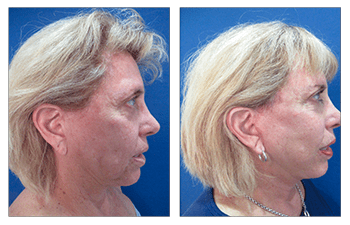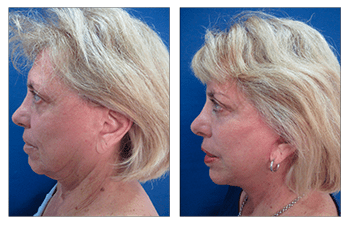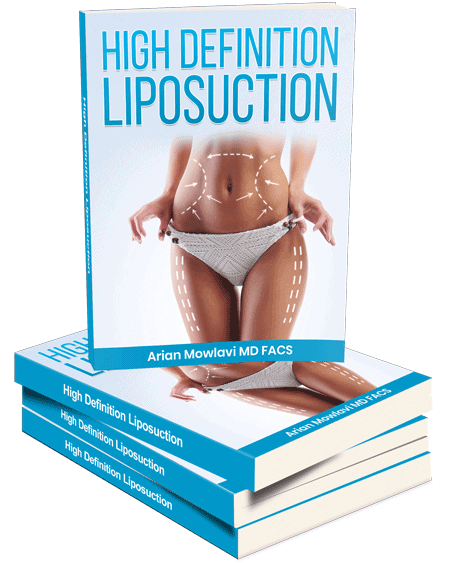Ideal neck contouring requires the elimination of neck fullness by using several independent measures. The first includes the elimination of all fat by using high definition liposuction to remove fat from both the deep and superficial fat from the area under the chin and laterally to the sternocleidomastoid muscle. Next, the muscle tissues in the neck, called the platysma, are tightened to optimize neck fullness.
The tightening of the platysma is performed by pulling the lateral edge of the platysma from each side in order to tighten the central platysma muscle redundancy. Finally, the redundant skin in the central neck is worked laterally to be removed with skin excisions. The skin excisions are performed and then the skin is transposed laterally and superiorly for repair around the ear.
Elimination of neck fullness
Fat removal of the neck must be customized to each patient’s needs. This involves marking of the patient’s neck fat position while the patient is sitting upright. The location of fat is most often centralized in the neck just under the neck. This is referred to as submental fat. The fat may extend down the neck and as fat as the collarbone. But it can also extend laterally out to the sternocleidomastoid muscles.
When performing liposuction laterally, there are two danger zones that your surgeon must be cautious of. The first is up high along the jawline, where there is a nerve called the marginal mandibular nerve. Injury to this nerve can result in paralysis of the lower lip muscles.
The second is down low along the jawline, where there are veins called the anterior jugular veins that branch out from one of the larger veins in the neck called the external jugular vein. Injury to the anterior jugular vein should be avoided as it will result in unnecessary bleeding into the neck that may compromise your results. When elimination of neck fullness is performed accurately, the improvements in neck contour are excellent.
Tightening of the neck muscles
At elimination of neck fullness, the tightening of the neck muscles includes a draped platysma that spans through the entire neck extending from one sternocleidomastoid muscle to the other. Tightening of this muscle is routinely performed as it is approached from the lateral neck an incision made behind the ear.
The incision behind the ear allows for the lifting of the lateral neck skin up to the lateral edge of the platysma which is identified along the medial border of the sternocleidomastoid muscle. Sutures are utilized to tighten the lateral edge of the platysma muscles.
During the elimination of neck fullness surgery, tightening the lateral edge of the platysma will result in the tightening of the central platysma muscles. Great care is taken when performing suture tightening of the lateral platysma muscles to avoid inadvertent injury to the external jugular vein that is located just beneath the sternocleidomastoid muscle.
Excision of redundant skin
Excision of redundant skin is performed by undermining the redundant skin of the neck throughout. In essence, the neck skin is lifted like a hammock and the redundant skin is redraped laterally. The elimination of neck fullness is excised laterally from incision lines placed around and behind the neck.
Once the neck skin redundancy has been trimmed out, the neck skin is redraped and repaired. The most important component in elimination of neck fullness involves utilizing the appropriate vector of pull to optimally eliminate skin redundancy.
In summary, elimination of neck fullness will be optimally performed when all three components of neck fullness is addressed. This elimination of neck fullness requires addressing fat accumulation, platysma neck fullness, as well as skin redundancy.
When all of these components are addressed optimally, superior neck skin contour improvements are appreciated. If you have been thinking about elimination of neck fullness, we encourage you to make a complimentary consultation with Our Surgical Team.
A 68-year-old female patient showing elimination of neck fullness following extended SMAS dual-plane lift.









